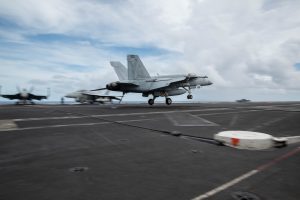The U.S. Navy announced that the USS Ronald Reagan and USS Nimitz strike groups are operating together in the Philippine Sea. This is second time two carriers have worked together in the region in as many weeks as the U.S. Navy seeks to reestablish a credible presence in the region and counterbalance China’s navy.
Last week the Nimitz strike group also conducted dual carrier operations in the Philippine Sea with the USS Theodore Roosevelt strike group after the latter went back to sea after spending two months in Guam to contain a coronavirus outbreak onboard.
The Philippine Sea is strategically located in the region as it provides access to both the Taiwan Strait and the South China Sea. China has stepped up its military intimidation of Taiwan in recent months with increased incursions near the median line between Taiwan and mainland China, drills and maritime presence, and overflights of contested airspace.
According to the admiral in charge of the Nimitz strike group, “dual carrier operations demonstrate our commitment to regional allies, our ability to rapidly mass combat power in the Indo-Pacific, and our readiness to confront all those who challenge international norms that support regional stability.”
Each U.S. aircraft carrier carries more than 5,000 sailors and over 60 jets and helicopters. Together, they can coordinate potent, 24-hour flight operations. The U.S. Navy says the dual carrier operations support “air defense drills, sea surveillance, replenishments at sea, defensive air combat training, long range strikes, coordinated maneuvers and other exercises.”
Escorting the two aircraft carriers are two cruisers and three destroyers.
For more than a month this spring the United States had no carriers operating in the Western Pacific while the Theodore Roosevelt was in Guam and the Ronald Reagan, which is permanently based in Japan, completed a previously scheduled intensive maintenance and repair period.
China used the gap in U.S. Navy carrier presence to highlight its own success dealing with the coronavirus and continuing its campaign of harassment and intimidation against its South and East China Sea neighbors. The U.S. Navy responded by sending all four of its forward-deployed submarines to sea and keeping up a high volume of presence and freedom of navigation operations by smaller warships such as destroyers and cruisers.
While it is not unusual for the United States to have multiple carriers in in the Western Pacific at the same time it is less common for those carriers to operate together. Earlier this month it was widely reported that the Navy was operating three aircraft carriers in the Pacific, the Theodore Roosevelt, Ronald Reagan, and Nimitz. While it is unusual for more than two aircraft carriers to be operating or deployed in the Pacific at one time, they usually work independently.
According to the Navy, dual carrier groups operated together in the Philippine or South China Seas in 2018, 2014, 2009, and 2001. The irregularity of those prior events suggests the U.S. Navy is making a concerted effort to dissuade China’s maritime assertiveness and reassure its allies and partners that the United States still operates the Pacific’s most capable fleet and has unique abilities to concentrate and project naval power in the region.

































